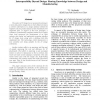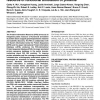41 search results - page 1 / 9 » Improving interoperability between microbial information and... |
BMCBI
2005
13 years 4 months ago
2005
Background: Biological resources are essential tools for biomedical research. Their availability is promoted through on-line catalogues. Common Access to Biological Resources and ...
BMCBI
2004
13 years 4 months ago
2004
Background: Multi-locus sequence typing (MLST) is a method of typing that facilitates the discrimination of microbial isolates by comparing the sequences of housekeeping gene frag...
BMCBI
2008
13 years 4 months ago
2008
Background: The process of horizontal gene transfer (HGT) is believed to be widespread in Bacteria and Archaea, but little comparative data is available addressing its occurrence ...
ISQED
2003
IEEE
13 years 9 months ago
2003
IEEE
The nature of IC design has is necessarily evolving to a more data-centric design flow in which EDA tools share a common information in a design database without the negative cost...
NAR
2002
2002
The Protein Information Resource: an integrated public resource of functional annotation of proteins
13 years 4 months ago
The Protein Information Resource (PIR) serves as an integrated public resource of functional annotation of protein data to support genomic/proteomic research and scientific discov...


